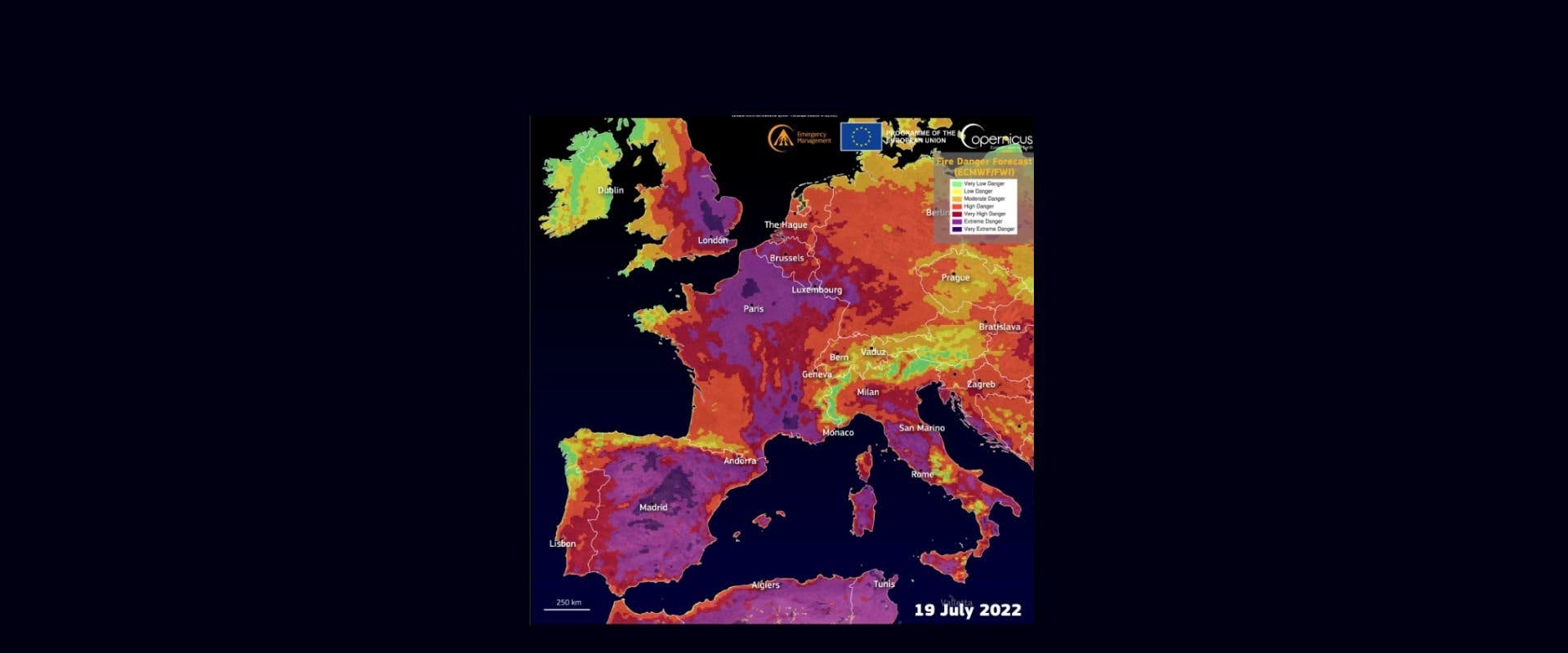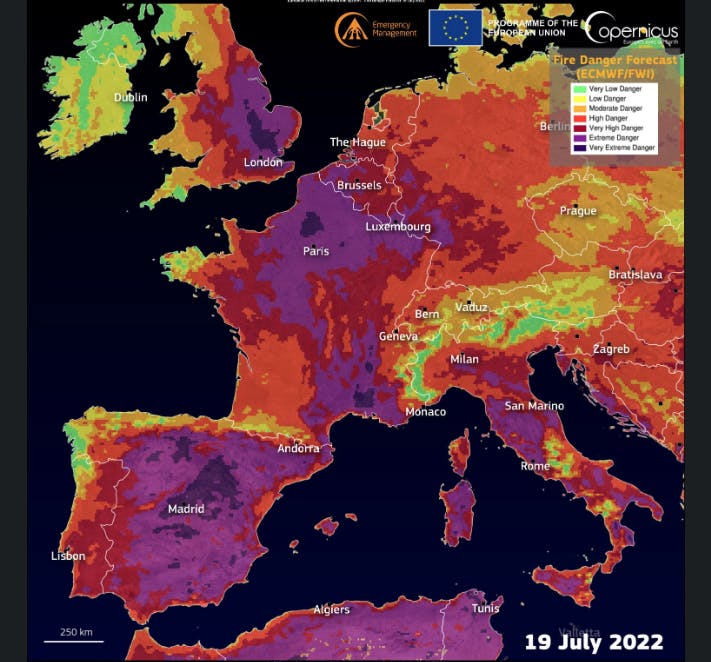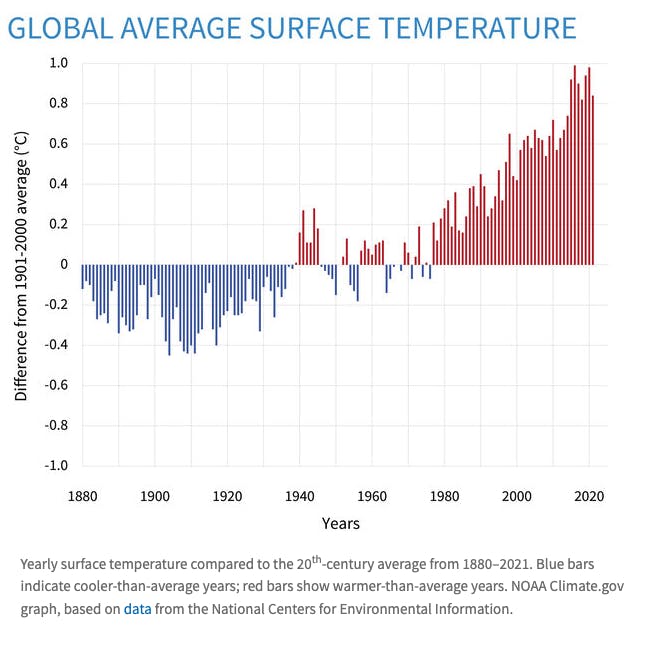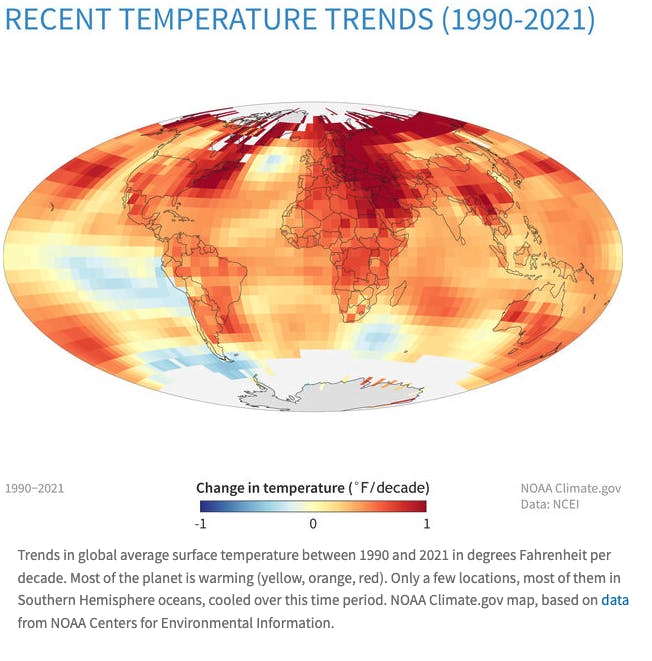The Wildfire-Climate Change Cycle and How to Tame it

As global temperatures increase with climate change, wildfires are becoming more frequent and more severe. The impact of wildfires on humans, the built environment and ecosystems is not only damaging in the short term. The longer term consequences are especially concerning. In a giant feedback loop, wildfires release huge quantities of carbon dioxide which further contribute to global warming and hence enable more wildfires. Alongside reactive firefighting responses, it is now imperative that we take more proactive measures to conserve and restore the resilience of our ecosystems. Data capture, ecosystem analysis and environmental management are vital for this. Dendra System’s expertise in these areas has much to contribute.
The recent images of wildfires in southern and western Europe make for grim viewing and the facts behind them are alarming. In France, record-high temperatures have been registered across much of the country with experts warning that western France is facing a “heat apocalypse”. In recent days, wildfires have forced over 24,000 people to evacuate their homes and 1,500 hectares of land in southwestern France have been burnt. Spain and Portugal have also seen blazes force thousands to flee and more than a thousand fatalities have been attributed to the heatwave as temperatures have exceeded 45°C. On one recent day, Portugal recorded 125 wildfires – the highest number for a single day this year. Even before the recent heatwave Portugal was already suffering a drought with 96% of the country facing severe or extreme conditions. In Italy meanwhile, its longest river, the Po, is experiencing the worst drought in 70 years with the potential to impact around a third of the country’s agricultural production¹,²,³ .

Figure 1: Fire Danger Forecast, Europe, Copernicus, https://effis.jrc.ec.europa.eu/
Diverse dangers
The impacts of wildfires are equally worrying and have critical consequences for human life, local and national economies, and for the environment that can extend days, weeks, and even years after a blaze is over. The effects of wildfires include⁴,⁵ :
- Respiratory and cardiovascular problems.
- Building and infrastructure damage and destruction.
- Degradation of watersheds by burnt vegetation (soil filter capacity is damaged, resulting in lower downstream water quality, which affects potability for humans as well as aquatic food sources).
- Soil erosion, causing further watershed compromise (reduced sunlight and dissolved oxygen in water plus excessive nutrients also harm aquatic life and therefore, potential human food sources).
- Huge damage to ecosystems that can push some plant and animal species closer to extinction (the 2020 Australian bushfires, for example, are estimated to have killed billions of both domesticated and wild animals; the 2021 wildfires in Latin America’s largest tropical wetland, the Pantanal, destroyed almost a third of one of the world’s greatest biodiversity hotspots and it may never fully recover).
A growing thread
Globally, in the next few decades, wildfires are expected to become both more intense and more frequent due to climate change and land-use change. Extreme fire events are projected to increase by up to 14% by 2030, 30% by 2050, and 50% by the end of the century. Increasingly, scientists are proposing a clear link between climate change and wildfires with higher temperatures, drier weather and windier conditions all increasing their likelihood and impact⁷,⁸. A study published in June 2022 in the journal ‘Environmental Research: Climate’ concluded it was highly probable that climate change was making heatwaves worse. And according to a study by environmental scientists at Oxford University, heatwaves and drought conditions are worsening wildfires, particularly ‘megafires’ that burn more than 100,000 acres. The scientists also found that “pretty much all heatwaves across the world have been made more intense and more likely by climate change”⁹.
It is sobering to consider all this against the backdrop of the 2015 Paris Agreement, whose goal is to keep the mean global temperature to well below 2°C above pre-industrial levels and preferably to 1.5°C. Currently, however, the world has already warmed by 1.1°C since the start of the industrial era¹⁰ (see Fig.2). 2021 was the sixth warmest on record, and the years 2013 – 2021 all rank among the ten warmest (see Fig 3. for temperature trends over the last three decades)¹¹. If yearly emissions continue to increase rapidly, as they have since 2000, models project that by the end of this century, the global temperature could be nearly 3°C warmer than the 1901-1960 average, and possibly as much as twice that¹².

Figure 2: Global Average Surface Temperature*13

Figure 3: Recent Temperature Trends (1990-2021)*14
Vicious cycle
This is a disastrous prospect given that wildfires and climate change are mutually exacerbating. Climate change makes wildfires worse by increased drought, high air temperatures, low relative humidity, lightning, and strong winds resulting in hotter, drier, and longer fire seasons. At the same time, climate change is made worse by wildfires ravaging sensitive, carbon-rich ecosystems like rainforests and peatlands¹⁵. Of course, not all fires are harmful – some serve important ecological purposes. In many fire-adapted ecosystems, fire helps to maintain vegetation structure, biodiversity, reproduction, and ecosystem function. In dry, fire-prone regions, fire (when infrequent and non-excessive) is beneficial in decomposing biomass. Many open-canopied woodlands, grasslands and sedgelands are maintained by frequent fire¹⁶. Indeed, humans may play an active part in the process via deliberate fire management. In Australia, for example, the indigenous peoples have been using and controlling fire for thousands of years in order to modify the landscape. Small, controlled fires help them to hunt, clear pathways through the land and regenerate vegetation. Australia’s flora and fauna have therefore evolved to live with fire, and now many species rely on these small, controlled burns to create the right mix of habitat for them to survive¹⁷).
Globally, however, wildfires are now burning longer and hotter in places where they’ve regularly occurred. They are flaring up in unexpected places, too, in drying peatlands and on thawing permafrost. Increasingly, there is the potential for a giant feedback loop: wildfires cause huge quantities of carbon dioxide to be released into the atmosphere, and this, in turn, causes more global warming, which results in more wildfires¹⁸.
Invasive species
Whilst climate change raises the risk of wildfires (and vice versa via the feedback loop), the problem is exacerbated by human activity, including the accidental or deliberate introduction of invasive flammable plant species into ecosystems. Such invasions change the ‘fuel’ available and can make fires more frequent and intense. Plantations of highly flammable exotic tree species, such as pines and eucalypts, probably helped fuel catastrophic fires in Portugal and Chile in recent years. And the introduction of exotic grasses into arid regions such as parts of the US southwest has transformed shrublands as fires increase in severity¹⁹.
The relevant characteristics of invasive species can include thick bark, the ability to resprout post-fire, and seeds that survive burning. If the invasive species have such characteristics, they can outcompete native species after a fire and further dominate the ecosystem. An invasion will therefore likely lead to more fires, changing the species composition and function of the ecosystem in a fire-vegetation feedback loop. In extreme examples of this dynamic, flammable grasses or shrubs can invade forests, leading to the loss of whole forest ecosystems²⁰.
Three years ago, a study across the US that analyzed several invasive grasses found that the grasses had increased fire frequency by as much as 150% and that many of the ecosystems studied were now vulnerable to an ongoing grass-fire cycle²¹. Another study – this time in the western US – identified cheatgrass as perhaps the most damaging of all the country’s invasive grasses²². Cheatgrass produces enormous amounts of seed that remain viable for years and germinate quickly under the right conditions. It spreads easily by wind and is carried by the fur of many mammals (and also on a human’s boots and socks). And though cheatgrass lives for just one season and then dies, it does so just in time to be highly flammable at the start of a typical fire season. The resultant wildfires are becoming hotter and more frequent, so the less-adapted native plants are killed off. In addition, the soil is degraded, making native regeneration more difficult and also riper for re-invasion by more cheatgrass. In this way, cheatgrass can easily overtake a landscape and outcompete native plants, often creating vast monocultures. The grass has little to no value as forage or cover for wildlife, but it decimates the forage available to wildlife and livestock. And without the biodiversity that lives for more than one growing season, there is little to hold the soils together and retain moisture.
Don’t just react, proact as well
So what can be done given that the latest IPCC report says weather conducive to wildfires is getting more frequent and will continue to increase with higher levels of global warming? Clearly, once a wildfire has started, firefighters and other emergency personnel must respond as best they can. But reactive approaches are not enough. A recent United Nations report, Spreading like Wildfire: The Rising Threat of Extraordinary Landscape Fires, calls for a radical change in government spending on wildfires, shifting – or at least re-balancing – their focus and funding from reaction and response to prevention and preparedness. Currently, direct responses to wildfires typically receive over half the spending, whilst planning receives less than one per cent. The report argues that two-thirds of relevant expenditure should be on planning, prevention, preparedness, and recovery, with only one-third for response and suppression.
The report acknowledges the immense damage that wildfires can do to ecosystems, not just during an actual occurrence but longer term as well. For example, wildfires in some US chaparral ecosystems are causing severe degradation: because of fire frequency, native resprouting species fail to regenerate, wood cover is replaced by grassy scrubland, invasive weeds dominate, hydrological cycles are disrupted, and major erosion events occur. Understanding ecosystems and their vulnerability or adaptability to fire is essential. To prevent wildfires from starting in the first place, the report calls for greater use of data and science-based monitoring systems combined with indigenous knowledge and stronger regional and international cooperation. The report recognizes the vital part that ecosystem restoration can play in minimising the risk of wildfire occurrence and building back better if they do occur.
Whilst reactive responses will always be critical, proactive measures to conserve and restore the resilience of native vegetation are necessary too. For example, high-flammability invasive weeds should be identified and removed early from ecosystems. And the strategic planting of low-flammability species as firebreaks can also be a valuable tool in fire management.
Data collection and analysis have an important role in assessing ecosystems and their responses to fire regimes. And that’s where Dendra Systems comes in. Our expertise is founded in ecosystem data capture and machine learning analysis. We can offer profound insights into ecosystems and, therefore, optimal strategies for environmental management. You can find out more about us and how we can help here.
References
- BBC News: https://www.bbc.co.uk/news/world-europe-62206006
- Independent.co.uk: https://www.independent.co.uk/climate-change/news/heatwave-wildfires-france-europe-evacuated-b2121994.html
- Reuters: https://www.reuters.com/business/environment/spain-portugal-battle-wildfires-heatwaves-scorch-southern-europe-2022-07-17/
- United Nations Environment Programme (UNEP) (2022): https://www.unep.org/news-and-stories/press-release/number-wildfires-rise-50-2100-and-governments-are-not-prepared
- UNEP and GRID-Arendal (2022): https://www.unep.org/resources/report/spreading-wildfire-rising-threat-extraordinary-landscape-fires
- UNEP (2022)
- Phys Org (2017): https://phys.org/news/2017-12-invasive-weeds-wildfires-hotter-frequent.html#:~:text=Invasive%20plants%20are%20responsible%20for,examples%20of%20this%20occurring%20worldwide
- Reuters: https://www.reuters.com/world/climate-change-is-driving-2022-extreme-heat-flooding-2022-06-28/
- Reuters: https://www.reuters.com/world/climate-change-is-driving-2022-extreme-heat-flooding-2022-06-28/
- BBC News: https://www.bbc.co.uk/news/world-europe-62206006
- Climate Gov (2022): https://www.climate.gov/news-features/understanding-climate/climate-change-global-temperature
- Climate Gov (2022): https://www.climate.gov/news-features/understanding-climate/climate-change-global-temperature
- Lindsey and Dahlman (2022): https://www.climate.gov/news-features/understanding-climate/climate-change-global-temperature
- Lindsey and Dahlman (2022): https://www.climate.gov/news-features/understanding-climate/climate-change-global-temperature
- UNEP (2022)
- UNEP and GRID-Arendal (2022)
- The Nature Conservancy (2021): https://www.nature.org/en-us/about-us/where-we-work/asia-pacific/australia/stories-in-australia/bringing-indigenous-fire-back-to-northern-australia/
- UNEP and GRID-Arendal (2022)
- Phys Org (2017): https://phys.org/news/2017-12-invasive-weeds-wildfires-hotter-frequent.html#:~:text=Invasive%20plants%20are%20responsible%20for,examples%20of%20this%20occurring%20worldwide
- Phys Org (2017): https://phys.org/news/2017-12-invasive-weeds-wildfires-hotter-frequent.html#:~:text=Invasive%20plants%20are%20responsible%20for,examples%20of%20this%20occurring%20worldwide
- Fusco et al (2019): https://www.pnas.org/doi/10.1073/pnas.1908253116
- Theodore Roosevelt Conservation Partnership: https://www.trcp.org/2020/08/28/invasive-species-fueling-western-wildfires/